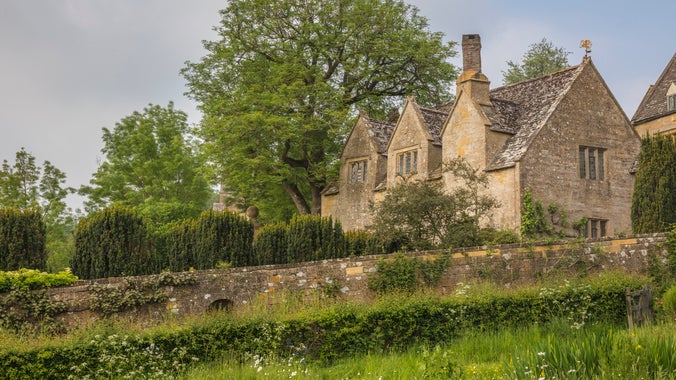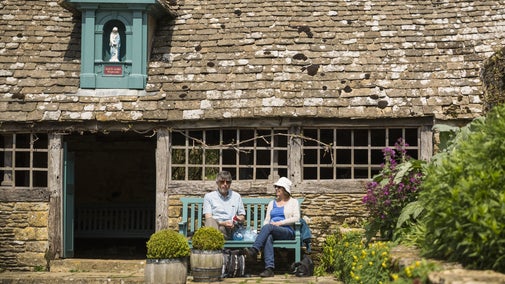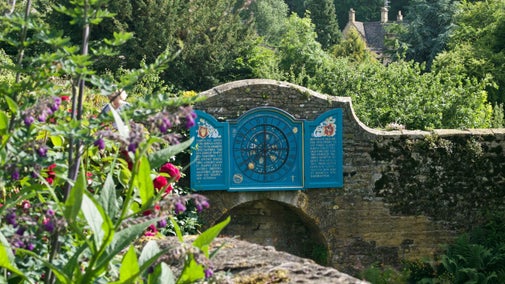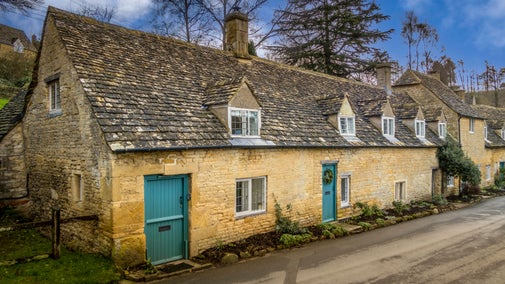
Become a member
Join today and help protect nature, beauty and history – for everyone, for ever. Enjoy access to more than 500 places with National Trust membership.
Snowshill is the unconventional home of the eccentric Charles Wade, who delighted in creating a stage for his life and passions.
Snowshill, near Broadway, Gloucestershire, WR12 7JU

| Asset | Opening time |
|---|---|
| Manor house | Closed |
| Garden | Closed |
| Priest's House | Closed |
| Shop | Closed |
| Café | Closed |
| Second-hand bookshop | Closed |
Weekends only - 8 November to 30 November. Open from 10.30 am. Last admission for the Manor is 1.30 pm and last entry into the property is 2.30 pm. Top floor of the manor closed for essential conservation.
| Ticket type | With Gift Aid | Without Gift Aid |
|---|---|---|
| Adult (18+) | £12.10 | £11.00 |
| Child (5-17) under 5s free | £6.10 | £5.50 |
| Family (2 Adults and up to 3 children) | £30.30 | £27.50 |
| Family one adult | £18.20 | £16.50 |
| Group (Adult 18+) | £10.45 | |
| Group (Child 5-17) | £5.23 |
Second hand book shop.
Motorhomes over 5 metres, please call 24 hours before your visit. If there is a space, we will confirm your booking. Please note, we are unable to accept motorhome bookings on any bank holiday weekend.
Dogs on short leads are very welcome at Snowshill Manor and Garden in the following areas: visitor reception, shop, outside the café, the picnic area, orchards, wildflower meadow, second hand bookshop and on the lawns and terraces in front of the manor. Assistance dogs only in the formal gardens, and inside the manor.
Six 11kW electric vehicle charging points are available in the main car park. Chargers can be accessed using mobile app, RFID card, or contactless payment device. Visit our EV charging provider RAW Charging's website (www.rawcharging.com/drivers) to download the app in advance of your visit.
Designated disabled parking in the main car park, accessible toilet near reception and café. Garden is a 500-yard hilly walk from reception. Café and shop.
You can access the full accessibility guide including a sensory map on the home page under the heading Accessibility.
A manor guide is available in braille form.
Accessible parking spaces next to visitor reception.
Please ask at reception upon arrival who can direct you to the drop-off point.
At visitor reception.
A manor guide is available in large print.
Access to the manor is on a tarmac path please be aware there is a slope.
We have a virtual tour and manor volunteers have further information and pictures to hand.
Access to the manor and slopes on paths.

Snowshill is the perfect place to visit as a group, as there’s so much to discover in the manor and garden so there’s something for everyone to enjoy.


Here you can find up-to-date information regarding access at Snowshill Manor and Garden. If you require any further assistance please give us a ring on 01386 852410.

The manor today is much as Charles Wade intended. Wade spent time carefully restoring and redesigning the building. He played with light, texture and colour to create a curated world filled with atmosphere and surprise.
The Arts and Crafts garden is an extension of the house, a series of outdoor rooms. It is filled with curious doorways, hidden vistas and unexpected delights.
Snowshill Manor is a treasure trove of quirky and curious objects. Charles Wade was fascinated by anything hand-crafted and made with skill. Items on display range from mechanical doorbells to suits of armour and costume.
Wolf’s Cove is a model harbour based on a typical Cornish fishing village. Charles Wade designed and built the miniature scene to delight anyone who came to visit. The creation features model buildings, people, canals and a railway scene.
The Snowshill café boasts beautiful views with indoor and outdoor seating, selling drinks, cakes, and light lunches.
The Snowshill shop sells souvenirs, homeware, books and local food and gifts.
Shop by the manor selling a range of second-hand books. Every purchase helps fund vital conservation work.
From blossom to wildflowers to apples, the orchards delight all year round.
With a sense of fun and theatre, Charles Wade took great pleasure in turning his home into a stage for his collection of varied and sometimes unusual finds.

Alongside friend and fellow architect Mackay Hugh Baillie Scott, Wade set out to design a garden which reflected the theatre and form of the manor. The garden is an extension of the house, a series of outdoor rooms.

There's plenty for the whole family to enjoy at Snowshill Manor and Garden from seasonal trails and activities to the Garden explorer notebooks and Wolf's Cove model village.

The café at Snowshill will provide welcoming refreshments during your visit. The shop stocks a wide range of gifts and souvenirs, and there's also a second-hand bookshop for picking up a pre-loved page-turner.


A cosy Cotswold cottage with plenty of original features and walks all around on the Cotswold Way.

A gorgeous cosy Cotswold cottage with heaps of original features and walks from the door.

A stable door and a woodburning stove make this pretty cottage perfect for a Cotswold country break.

With low-beamed ceilings and original inglenook, this little cottage is packed with Cotswold charm.
Enjoy this walk in rural Gloucestershire, exploring the beautiful countryside around Snowshill village and the Vale of Evesham.

Sorry, there are no upcoming events at this place
Snowshill is a place like no other: a world away from ordinary and the unconventional home of the eccentric Charles Wade. In an idyllic Cotswolds setting he used architectural and theatrical techniques to dramatic effect and produced an experience like no other. Snowshill is a place filled with colour and intrigue, a delight to the senses.
The garden is an extension of the manor set out in a series of rooms with far reaching views and unexpected delights including Wolf's Cove model village.
Find out more about Charles Paget Wade (1883–1956, an avid collector who donated his entire home and collection to the National Trust.

Designed by Charles Wade and his friend, prominent Arts and Crafts architect Mackay Hugh Baillie Scott, in 1920, discover how this former farmyard became a country manor garden.

Explore the objects and works of art we care for at Snowshill on the National Trust Collections website.

Volunteering at Snowshill can be fun, interesting and rewarding so why not check out the range of roles to suit all interests across the manor and garden?


Join today and help protect nature, beauty and history – for everyone, for ever. Enjoy access to more than 500 places with National Trust membership.
By sharing your email address you’re agreeing to receive marketing emails from the National Trust and confirm you’re 18 years old or over. Please see our for more information on how we look after your personal data.